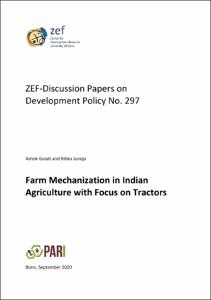Gulati, Ashok; Juneja, Ritika: Farm Mechanization in Indian Agriculture with Focus on Tractors. Bonn: Center for Development Research (ZEF), 2020. In: ZEF Discussion Papers on Development Policy, 297.
Online-Ausgabe in bonndoc: https://hdl.handle.net/20.500.11811/9508
Online-Ausgabe in bonndoc: https://hdl.handle.net/20.500.11811/9508
@techreport{handle:20.500.11811/9508,
author = {{Ashok Gulati} and {Ritika Juneja}},
title = {Farm Mechanization in Indian Agriculture with Focus on Tractors},
publisher = {Center for Development Research (ZEF)},
year = 2020,
month = sep,
series = {ZEF Discussion Papers on Development Policy},
volume = 297,
note = {Our analysis shows that farm mechanization in India, especially the use of tractors, has made commendable progress. With major policy changes, entry of private farm machinery manufacturing companies and foreign collaborations, farm power availability increased from 0.25 kilowatt per hectare (kW/ha) in 1951 to 2.02 kW/ha in 2017. Furthermore, the contribution of mechanized sources to farm power increased from some 3 percent in 1951 to 88 percent in 2013-14, replacing human and draught power. In addition, the production of tractors increased significantly from a meager 880 units in 1951 to about 900,000 units in 2019. This has transformed India from being a net importer of tractors through the 1960s and 1970s to being an exporter of tractors, exporting some 92,000 units in 2019. In terms of inclusiveness, although larger farms are more mechanized, the Input Census data (2011-12) reveals that even in the category of small and marginal holdings (less than 2 ha), an average of roughly 44 percent of farmers use farm machinery (e.g., tractors, diesel engine pump sets, electric pump sets and power tillers). This is a good achievement, but further improvements are always possible and major attempts in this direction are already underway with heavy policy support through Custom Hiring Centres (CHCs). However, the fact that farm machinery is expensive also raises concerns over whether it is financially viable and sustainable to own and use on smallholder farms. It is therefore important to look at unfolding innovations providing farm machinery services through ‘CHCs’ and ‘Uberization’ models. These innovations make farm machinery and equipments perfectly divisible as a service to all classes of farmers at the doorstep at affordable cost on a ‘pay per use’ basis. This seems to be the future of farm machinery usage in India, if it is developed as a sustainable business model with due support of policy and finance.},
url = {https://hdl.handle.net/20.500.11811/9508}
}
author = {{Ashok Gulati} and {Ritika Juneja}},
title = {Farm Mechanization in Indian Agriculture with Focus on Tractors},
publisher = {Center for Development Research (ZEF)},
year = 2020,
month = sep,
series = {ZEF Discussion Papers on Development Policy},
volume = 297,
note = {Our analysis shows that farm mechanization in India, especially the use of tractors, has made commendable progress. With major policy changes, entry of private farm machinery manufacturing companies and foreign collaborations, farm power availability increased from 0.25 kilowatt per hectare (kW/ha) in 1951 to 2.02 kW/ha in 2017. Furthermore, the contribution of mechanized sources to farm power increased from some 3 percent in 1951 to 88 percent in 2013-14, replacing human and draught power. In addition, the production of tractors increased significantly from a meager 880 units in 1951 to about 900,000 units in 2019. This has transformed India from being a net importer of tractors through the 1960s and 1970s to being an exporter of tractors, exporting some 92,000 units in 2019. In terms of inclusiveness, although larger farms are more mechanized, the Input Census data (2011-12) reveals that even in the category of small and marginal holdings (less than 2 ha), an average of roughly 44 percent of farmers use farm machinery (e.g., tractors, diesel engine pump sets, electric pump sets and power tillers). This is a good achievement, but further improvements are always possible and major attempts in this direction are already underway with heavy policy support through Custom Hiring Centres (CHCs). However, the fact that farm machinery is expensive also raises concerns over whether it is financially viable and sustainable to own and use on smallholder farms. It is therefore important to look at unfolding innovations providing farm machinery services through ‘CHCs’ and ‘Uberization’ models. These innovations make farm machinery and equipments perfectly divisible as a service to all classes of farmers at the doorstep at affordable cost on a ‘pay per use’ basis. This seems to be the future of farm machinery usage in India, if it is developed as a sustainable business model with due support of policy and finance.},
url = {https://hdl.handle.net/20.500.11811/9508}
}






